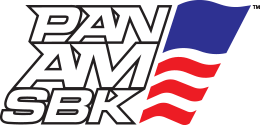Update: February 1, 2024
- Honda NSF250 is SuperBike Twins eligible. Honda NSF250 is not SuperStock Twins eligible
Update: January 3, 2024
-
- SuperStock and SuperStock Twins Light cc maximum has been updated to 690cc.
- Aprilia RS660 is not eligible for SuperStock Twins Light.
- Aprilia RS660 is eligible for SuperStock Twins Max.
- Aprilia RS600 is eligible for SuperBike Twins Light.
- One bonus point will be awarded to each class qualifying pole position.
Update: November 29, 2023
- Racers who go out in the incorrect qualifying session without prior approval will have their times from that incorrect session invalidated.
Update: November 24, 2023
- The Formula 40-600 and Formula 40-1000 classes will be combined into just the Formula 40-1000 race.
- Quick-change equipment that does not affect the riding performance will be permitted in SuperStock Classes.
- Front brake lever guards are required.
- One bonus point will be awarded to class pole winners.
- Racers must complete 75% for a Grande Corsa race to receive points.
- Crashes and mechanicals that result in a racer not completing the race will be marked as DNF and will not receive points (regardless of previous lap position).
- Formula Twins class is replaced with SuperBike Twins Light and Max
- Production Twin class is replaced with SuperStock Twins Light and Max
- An exception is being made in the SuperStock Twins Light and SuperBike Twins Light to allow for the ZX4 to compete in these classes.
- A technical exception is being made to allow for the rear wheel to be changed and remain SuperStock eligible.
Update: December 10, 2020
Rulebook Changes
- A counter-protest (against the protesting racer only) may be submitted within 30 minutes of receipt of the original protest.
Update: September 23, 2020
Rulebook Changes:
- The minimum weight rule has been removed.
- The restriction on the KTM 390 version has been removed from Moto3
- SuperStock 400 class was added.
- Protests must be filed within 30 minutes of the race finish.
- Team Championship
- Rosters will be limited to 8 racers all season.
- Initial rosters and any roster changes must be submitted prior to the start of race 1.
- Trio Cup was added
- 300 Pursuit race was added
Update: October 19, 2019
Rulebook Changes:
- Women’s Overall Champioship added.
- Bridgestone Cup removed.
- Vintage Cup added.
- SuperStock 300
- Rain tires are permitted.
- Optional equipment sold by the motorcycle manufacturer and aftermarket manufacturers for the OEM model are allowed (Power Commander, Bazzaz, etc.)
Update: October 20, 2018
Rulebook Update – Weight limits removed, SuperStreet quickshifter allowed, Format Change, Updated Penalties, Updated Team Championship rules / procedures
Update: June 19, 2018
Superstock / Superbike 1000 rules update clarifying engine cc specifications.
Update: June 10, 2018
Initial rollout and testing of race day text notification system
Update: April 19, 2018
Created custom URL’s for racers and race teams.
Update April 14, 2018
Separated Formula 40 & Formula 50 1000 qualifying from Sunoco Superbike 1000 qualifyer
Update: January 30, 2018
Combined Formula 40 600 qualifying with Sunoco Superbike 600 Qualifying. Combined Formula 40 1000 & Formula 50 1000 qualifying with Sunoco Superbike 1000.
Update: December 15, 2017
Added Masters Championship for racers 40 years and older.
Update: December 4, 2017
On the race results, the racer’s bike model is now displayed along with the make of the bike.
Update: November 28, 2017
Added average grid position and average finish position to racer profile page.
Update: November 26, 2017
Added bike and tire manufacturer results to the championship standings pages.
Update: November 6, 2017
Amateur to Expert status posted in section 17
Update: October 16, 2017
Clarified Formula Twins Superbike Rules
Added language to clarify Superbike rules as listed in section 6 for Formula Twins
Printer Friendly Racer Profile Page
If you need to provide potential sponsors with your racing “resume”, there is now a button on the upper right corner of the racer profile page that will allow you give you printer friendly version of your profile page. Depending what browser you are using, you could print the page directly to PDF file that you could email to your potential sponsor.
Update: October 8, 2017
2.12 Number plate colors Number plate colors
The background colors for EXPERT and PRO may be any color other than yellow. Border colors or number design is personal choice. Please make number and plate designs easily distinguishable from Amateur competitors.
The background colors and figures (numbers) for Amateur are yellow background with black numbers.
16. Team Championship
1. Team rosters can change each weekend.
2. Team rosters must be submitted on Saturday by 6:00 PM.
3. If a team roster is not submitted, the previous race weekend’s roster will be used.
4. Riders may switch teams, but the all accumulated points will remain with old team.
6. Points from the SuperStock 600, SuperBike 600, SuperStock 1000, SuperBike 1000, SuperStreet 250, SuperStreet 300, Moto3, Production Twin, and Formula Twin will be included in the team scoring.
7. There will be no limit on the number of racers on a team roster.
8. There will be no limit on the number of racers included in scoring.
8. Formula Twins
Four cylinder, water cooled up to 565cc
2.13 FUEL
Superbike – All fuel must be Sunoco RMR, Sunoco APEX, or Sunoco pump fuel provided by PanAmSBK at each venue unless otherwise
authorized. Sunoco RMR and APEX may be purchased from approved vendors.
Update: August 1, 2017
Racers Jonathon Holloway #762 and Fabian Alvarez #110 were placed on probation for the initial three (3) race weekends of the 2018 season in response to separate race incidents as well as loss of points in their respective races where the incidents occurred.

